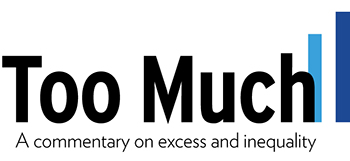Two decades of increasing inequality, a new state-by-state survey finds, have shoved poor and middle class Americans onto the same economic treadmill.
By Sam Pizzigati
Over the past two decades, reports a new state-by-state analysis of income in the United States released this week, America’s poor and middle class have been soulmates — in stagnation. Between 1987-1989 and 2004-2006, the average incomes of the bottom fifth of U.S. families increased just 11.1 percent — less than 1 percent a year — after adjusting for inflation. Over those same years, families in America’s middle fifth of families saw their incomes increase at an almost identical rate, just 13 percent, also less than 1 percent a year.
But Pulling Apart, the new income analysis from the Washington, D.C.-based Center on Budget and Policy Priorities and Economic Policy Institute, finds a totally different story at the top of America’s income ladder.
 Families in America’s top fifth have seen their incomes jump 36.1 percent since the late 1980s, with most of that jumping at the top fifth’s upper reaches. Over the last two decades, note Pulling Apart co-authors Jared Bernstein, Elizabeth McNichol, and Andrew Nicholas, incomes for America’s top 5 percent have catapulted 59.8 percent.
Families in America’s top fifth have seen their incomes jump 36.1 percent since the late 1980s, with most of that jumping at the top fifth’s upper reaches. Over the last two decades, note Pulling Apart co-authors Jared Bernstein, Elizabeth McNichol, and Andrew Nicholas, incomes for America’s top 5 percent have catapulted 59.8 percent.
Actually, the report takes pains to note, incomes at the top have increased even faster than that. The Census Bureau data Pulling Apart crunches, the authors emphasize, do not include capital gains on the sale of stocks and other assets, income that pours overwhelmingly into America’s richest pockets.
Pulling Apart, in broad strokes, traces the same rising inequality patterns that other income scholars have identified over recent years. But Pulling Apart offers plenty of fresh detail.
For starters, Pulling Apart offers an unusual glimpse at how much income U.S. families really have available to spend, after paying their federal taxes. The study, tapping data the Census Bureau collects every March, may not cover capital gains. But Pulling Apart does tally every other significant revenue stream that flows into American households, from Social Security and food stamps to interest and dividends.
Pulling Apart then breaks this data down by state, a step that documents the truly all-American phenomenon that inequality has become. Income gaps are widening in America’s every corner.
Some states, to be sure, are growing unequal at faster rates than others. In Connecticut, the state with the nation’s most rapidly growing income gap, the top fifth of families have enjoyed a 45 percent household income increase since the late 1980s, from $116,939 to $169,378, after inflation-adjusting to 2005 dollars.
Over that same period, the poorest fifth of Connecticut families have watched their average incomes drop 17 percent, from $25,570 to $21,133.
Two decades ago, Connecticut’s top fifth of families averaged 4.6 times the incomes of the state’s poorest fifth. Top-fifth Connecticut families now make 8 times the incomes of the state’s poorer families. The state’s income gap has nearly doubled.
What difference does this rising inequality make, in Connecticut or anywhere else in the nation? The authors of Pulling Apart do pause from their number-crunching to tackle that question. Wider gaps, they note, reduce “social cohesion” and widen “discrepancies in political influence.” With gaps growing greater, “families at the upper end of the income scale have less and less contact and familiarity with the problems faced by low- and middle- income families.”
These wealthier families eventually come to live in a separate world. This separation, in turn, unleashes a dangerous dynamic. One example: Affluent families that send their kids to private schools “can lose sight of the need to support public schools.” The predictable result: “Support for the taxes necessary to finance government programs declines, even as the nation’s overall ability to pay taxes rises.”
The victims of this dynamic, Doug Hall of the New Haven-based Connecticut Voices for Children advocacy group charged last week, will always end up to be a society’s most vulnerable. In deeply unequal Connecticut, he points out, lower-income families are struggling to make ends meet because they live amid an economy where the presence of extremely wealthy families has bid up the cost of housing and other basic commodities.
At the same time, Hall adds, Connecticut’s deep inequality has bred a political system remarkably insensitive to the needs of the struggling. Advocates for low-income children have tried 28 times to enact an earned-income tax credit for Connecticut’s poor. They’ve so far failed every time.
“We remain,” notes Hall, “the only state in New England with an income tax that does not have an earned-income tax credit.”
Sam Pizzigati edits Too Much, the online weekly on excess and inequality published by the Washington, D.C.-based Institute for Policy Studies.



Discussion
No comments for “America’s Income Soulmates”